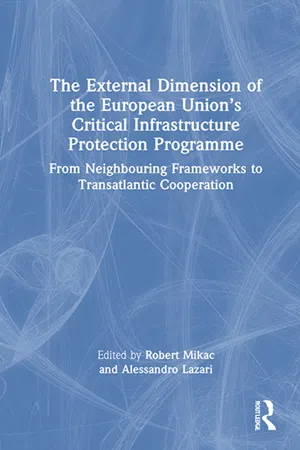
The External Dimension of the European Union’s Critical Infrastructure Protection Programme
From Neighbouring Frameworks to Transatlantic Cooperation
- 302 pages
- English
- ePUB (mobile friendly)
- Available on iOS & Android
The External Dimension of the European Union’s Critical Infrastructure Protection Programme
From Neighbouring Frameworks to Transatlantic Cooperation
About this book
External Dimension of the European Union's Critical Infrastructure Protection Programme: From Neighboring Frameworks to Transatlantic Cooperation provides the basis, methodological framework, and first comprehensive analysis of the current state of the external dimension European Programme for Critical Infrastructure Protection.
The challenges at the EU level are multidimension insofar as identifying, designating and protecting critical infrastructures with the ultimate goal of harmonizing different national policies of the Member States and creating the identity of the European Union in this arena. Modern society has become so reliant on various sectors of critical infrastructure—energy, telecommunications, transport, finance, ICT, and public services—that any disruption may lead to serious failures that impact individuals, society, and the economy. The importance of critical infrastructures grows with the industrial development of global and national communities; their interdependence and resiliency is increasingly important given security threats including terrorism, natural disaster, climate change and pandemic outbreak
In the area of Critical Infrastructure Protection and Resilience, the European Union is constantly committed to setting the objectives for the Member States. At the same time, the European Commission promotes the importance of a common approach to Critical Infrastructure Protection (CIP), and ensure cooperation beyond the borders of the Union, while also cooperating with neighboring countries, including those soon willing to join the European Union.
This book has been structured and written to contribute to current critical infrastructures, resilience policy development and discussions about regional and international cooperation. It serves as a reference for those countries willing to initiate cooperation and that therefore demand deeper knowledge on the security cultures and frameworks of their potential partners.
Features:
- Provides an unprecedented analysis of the national frameworks of 14 neighboring countries of the EU, plus the United States and Canada
- Overcomes the language barriers to provide an overall picture of the state of play of the countries considered
- Outlines the shaping of national critical infrastructure protection frameworks to understanding the importance of service stability and continuity
- Presents guidelines to building a comprehensive and flexible normative framework
- Addresses the strategic and operational importance of international co-operation on critical infrastructure including efforts in CIP education and training
- Provides insight to institutions and decision-makers on existing policies and ways to improve the European security agenda
The book explains and advocates for establishing stronger, more resilient systems to preserve functionalities at the local, national, and international levels. Security, industry, and policy experts—both practitioners and policy decision-makers—looking for answers will find the solutions they seek within this book.
Frequently asked questions
- Essential is ideal for learners and professionals who enjoy exploring a wide range of subjects. Access the Essential Library with 800,000+ trusted titles and best-sellers across business, personal growth, and the humanities. Includes unlimited reading time and Standard Read Aloud voice.
- Complete: Perfect for advanced learners and researchers needing full, unrestricted access. Unlock 1.4M+ books across hundreds of subjects, including academic and specialized titles. The Complete Plan also includes advanced features like Premium Read Aloud and Research Assistant.
Please note we cannot support devices running on iOS 13 and Android 7 or earlier. Learn more about using the app.
Information
1 INTRODUCTION
- Introduction and methodology
- The External Dimension of the European Union’s Critical Infrastructure Protection: From Neighboring Policy to Transatlantic Cooperation
- Republic of Croatia: Terms of Reference for Neighboring Countries
Chapter 1Introduction and Methodology
Contents
- 1.1. Research Background
- 1.2. Subject of Research Interest
- 1.3. Research Focus
- 1.4. Methodological Framework
- 1.5. The Book Structure
1.1. Research Background
- 1) All activities are undertaken primarily by the critical infrastructure owner or manager to prevent internal and external challenges from harming the continuous functioning of the infrastructures.
- 2) Measures and actions were taken by the state to:
- establish a normative framework.
- ensure the development of this area.
- develop systems for strengthening resilience and protection of key processes and infrastructures in its territory.
- establish clear competencies and relationships between different stakeholders (system coordinator, competent ministries, security coordinators, regulatory agencies, facilities, networks, and systems that are critical infrastructure).
- develop public-private partnerships and collaborations within the international community and the organizations to which it belongs or whose membership it seeks.
1.2. Subject of Research Interest
Table of contents
- Cover
- Half Title
- Title
- Copyright
- Contents
- List of Abbreviations
- List of Figures
- List of Tables
- Acknowledgments
- Foreword
- Editor Biographies
- Contributor Biographies
- Part One Introduction
- Part Two EU Enlargement Agenda
- Part Three Eastern Partnership
- Part Four Transatlantic Cooperation
- Part Five Overview and Conclusion
- References
- Index